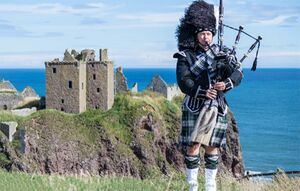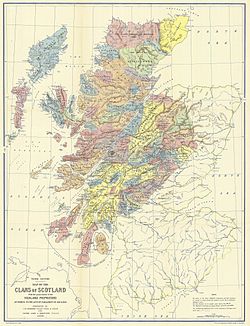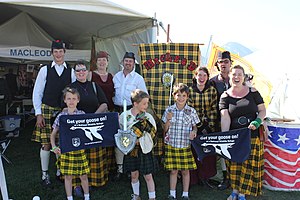
The Clans of Scotland are one the most iconic and internationally recognised feature of the nation. Scotland's clan system has a long and rich history. At its simplest a clan is an extended family, with kinship ties binding related branches of the same family tree and different surnames linked through a common shared history. The origins of the clan system are ancient, possibly dating back over a millennia, long before Scotland itself could be considered a nation[1]. The word clan comes from clann, the Scots Gaelic for "offspring" or "children"[2].
Almost inevitably anyone with Scottish ancestors will ask themselves whether they have a clan connection. Equally, exploring someone's Scottish heritage through clans is a great way to learn about them and how the clans may have shaped your ancestors' lives and experiences.
But not everyone with Scottish ancestors necessarily can trace themselves to a historical clan. It's been estimated that well over half of Scottish families do not have a direct link to the ancient Highland and Island clans, reflecting that many Scottish surnames actually reflect occupations or districts, not clans[3].
A brief history of Scottish clans

The first Scottish clans were formed in the Highlands, where the terrain was difficult to control and there was a constant threat of attack from Vikings and other invaders. Powerful warlords or chiefs emerged to provided protection and leadership to their followers, forming a nascent clan. In return, the followers were loyal to the clan chief and were willing to fight on their behalf.
The clans continued to develop in number and influence through the 13th and 14th centuries. They became increasingly important in Scottish politics, playing a major role in bloody conflicts as England repeatedly attempted to subjugate Scotland. But over the 15th and 16th centuries the clans themselves became increasingly divided, with many bloody feuds.
The clans reached their peak of power in the 17th century. Following the Jacobite uprisings[4] in the mid-18th century Scottish clan culture was deliberately suppressed through policies aimed at large scale rural de-population. Many clan members were killed or evicted from their historical lands, which were then given to supporters of the Crown. The wearing of the plaid and kilt, playing of the pipes, carrying of arms, speaking Gaelic and gatherings for games were all banned under the Act of Proscription of 1746. It was repealed 36 years later but by then the Highlands and their clans had changed in fundamental ways[5]. Since then clans have made a comeback in Scotland popular culture and today they are a key element of national identity. Many Scottish people revel in their clan relationship. Today there are a huge range of clan-related events held throughout Scotland each year. A parade, The Great Clan Gathering, through the streets of the Scottish capital, Edinburgh, is a highlight of annual clan celebrations[6].
Exploring your possible clan heritage
It is likely that any family historian interested in exploring potential clan heritage will already be aware of some Scottish connection. This might come from the known birthplace in Scotland of a family ancestor; available documentation such as birth, marriage or death certificates; or just hand-me-down knowledge from an older relative. With this information you can can continue your research though the many websites and books devoted to the clans[7].
Famous Scottish clans include[8]:
| Stewart | Douglas | Murray | Fraser |
| Campbell | MacDonald | Macgregor | Robertson |
| Gordon | MacKenzie | MacCleod | Gunn |
| Wallace | Davidson | Munro | Mackintosh |
A further potential route to exploring clan connections is DNA testing, available through MyHeritage DNA. These tests can provide a strong indication of a link to Scottish ethnicity and even a particular geography which might assist you in narrowing down a possible connection to the clan or clans most closely associated with that region.
Sources of information on clans
Useful sources of information on the clans include:
- The National Records of Scotland (NRS): The NRS is the official archive for Scotland. It offers a wide variety of records, including census records, birth certificates, marriage licenses, and death certificates. You can search their records online or visit their offices in Edinburgh.
- The Scottish Genealogy Society (SGS): The SGS is a non-profit organization that provides information and support for family historians. Among its resources is Family History Index of over 2,700 separate files deposited by researchers with the Society over many years. Each file contains research on a specific family or number of families in the form of research notes, random jottings, family group sheets, pedigree charts, family trees, original documents, transcripts, newspaper cuttings, photographs and even fully written up histories.
- SCOTCLANS: Offers a website listings for over 400 Scottish Clans and Families. It includes histories, tartans crests, clan lands and an extensive database of clan images. It also enables you to discover whether a particular surname has a connection to a clan or to a Scottish family armiger (a person entitled to bear heraldic arms, such as a sovereign or nobleman).
- Electric Scotland: Provides online historical accounts of most of the major Scottish and Scots-Irish clans. It also offers excellent background reading on individual Scots and Irish families as well as links to other relevant online resources.
Having your clan connection recognised or joining a clan even without a historic connection

Scottish clans are communities united by a common interest. To join a Scottish clan, you need to contact the clan society or association you're interested in. Each clan has its own membership requirements, so you will need to check with a specific clan. Some clans require you to prove your Scottish ancestry and may also have specific requirements for participation in particular clan activities.
But it is also possible to join a Scottish clan even if you don't have any direct Scottish ancestry. In recent years many clans have relaxed their membership requirements and now welcome anyone who is interested in Scottish culture and heritage. They may, however, require you to pay a membership fee.
Explore more about the Clans of Scotland
MyHeritage offers hundreds of historical record collections from Scotland. Collections which are most directly relevant to research on clans include:
- History of the Macdonalds And Lords of the Isles (1881)
- Complete Peerage of England, Scotland And Ireland, Together With an Extinct Peerage of the Three Kingdoms, Volume 2 (1809)
- History of the Scottish Highlands Highland Clans And Highland Regiments (1885)
- Records of the Clan And Name of Fergusson, Ferguson And Fergus, (1895)
- History of the Clan Gregor, From Public Records And Private Collections, Comp. at the Request of the Clan Gregor Society (1898)
Family Trees created and maintained by other MyHeritage members offer an invaluable tool to find information on people of interest to you who appear in their trees. By searching on geographical criteria such as place of birth you should be able to focus in on ancestors in other family trees with a connection to Scotland and to which you may be related.
There is a vast range of books and articles which provide another source of information on Scottish clans. The websites and references noted in this article will direct you to some of these titles.
References
- ↑ Culturetrip. (2023, August 22). A brief history of the scottish clan system. Culture Trip.
- ↑ Wikimedia Foundation. (2023, May 19). Scottish clans. Wikipedia.
- ↑ DeBrohun, D. (2020, May 12). Were my ancestors part of a Scottish clan?. Scottish American Insider.
- ↑ Wikimedia Foundation. (2023b, August 19). Jacobite rising of 1745. Wikipedia.
- ↑ Scottish clans. Scotland. (n.d.).
- ↑ The Great Clans of Scotland. Historic UK. (n.d.).
- ↑ Clan History books. Scottish Clan History Books - Over 40 Different Clan Names. (n.d.).
- ↑ What are Scotland’s most famous clans, and why? CLAN. (n.d.).